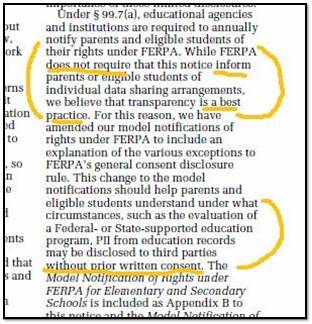Christel Swasey wrote this fact-check post on her site. I have included Judy Park’s full email below for reference, as well as comments from 2 of the 15 parent assessment review panel members which seem to contradict Judy Park’s claims.
**************
From Christel Swasey
Once again it seems necessary, unfortunately, to provide a fact-checking rebuttal to statements made by Utah’s Associate Superintendent Judy Park about student data privacy.
In a letter given out to parents of children attending a St. George charter school recently, Judy Park was quoted at length. Park, the Associate Superintendent of Utah, made the following statements that will be scrutinized here with links to opposing evidence.
In that letter, Ms. Park wrote:
“The advocates of anti-common core are falsely accusing USOE and schools and districts of collecting and storing data that is “behavioral data and non-academic personal information”. They have no real evidence or examples to support this claim. The only data that is collected and maintained is the specific data required by state and federal law.”
Here’s evidence to the contrary, Ms. Park.
1. First, there is a Utah law about Common Core standardized tests. This law, HB15, created in 2012, requires the collection of behavior indicators. It calls for “ the use of student behavior indicators in assessing student performance” as part of the testing. This is Utah’s S.A.G.E. –aka Common Core or A.I.R.– test.
2. There is a company that Utah has paid at least $39 million to write its Common Core-aligned standardized tests: American Institutes for Research. Its mission: “AIR’s mission is to conduct and apply the best behavioral and social science research and evaluation…“
Are we to believe that although AIR’s purpose is to test behavioral and social indicators, and although Utah law says that the test must test behavioral indicators, the test still won’t?
3. Utah’s SLDS grant application talks about authorizing de-identification of data for research and says that individuals will be authorized to access personal student information in the various Utah agencies that belong to UDA. (Who are these individuals? Why does the UDA trust them with information that parents weren’t even told was being gathered on our children?)
Starting at page 87 on that same SLDS federal application, we read how non-cognitive behaviors that have nothing to do with academics, will be collected and studied by school systems. These include “social comfort and integration, academic conscientiousness, resiliency, etc.” to be evaluated through the psychometric census known as the “Student Strengths Inventory. (SSI)” That SSI inventory –my child’s psychological information– will be integrated into the system (SLDS). Nonacademic demographic and other personal information is also captured while administering the test. SSI data will be given to whomever it is assumed, by the so-called leadership, that needs to see it. (This should be a parental decision but has become a state decision.)
The SLDS grant promises to integrate psychological data into the state database. “Utah’s Comprehensive Counseling and Guidance programs have substantial Student Education Occupation Plan, (SEOP) data, but they are not well integrated with other student data. With the introduction of UtahFutures and the Student Strengths Inventory (SSI) and its focus on noncognitive data, combining such data with other longitudinal student level data to the USOE Data Warehouse the UDA.” It also says:
“… psychosocial or noncognitive factors… include, but are not limited to educational commitment, academic engagement and conscientiousness, social comfort and social integration, academic self-efficacy, resiliency… Until recently, institutions had to rely on standardized cognitive measures to identify student needs. … We propose to census test all current student in grades 11 and 12 and then test students in grade 11 in subsequent years using the Student Strengths Inventory (SSI) – a measure of noncognitive attitudes and behaviors.” So the Student Strengths Inventory (SSI) is a “psychometric census” to be taken by every 11th and 12th grade student in Utah. That’s one way they’re gathering the psychological data.
4. Ms. Park herself is a key player and even a writer for the Council of Chief State School Officers (CCSSO) –the organization that co-created and co-copyrighted Common Core. This makes me fairly confident that you are aware of what the CCSSO stands for and what its goals are. On the CCSSO website, it states that one of its main goals is “Continued Commitment to Disaggregation” of student data. Disaggregation means that academic bundles of students’ information will be separated into groups that are increasingly easy to identify individually.
Lastly, there is this issue: Ms. Park wrote, “The only data that is collected and maintained is the specific data required by state and federal law.” This is a big problem since the state and the federal requirements do not match anymore. The state is much more protective of students’ rights. Federal FERPA regulations have been altered –not by Congress but by the sneaky Department of Education (DOE). The DOE changed the definitions of terms. They reduced from a requirement to only a “best practice” the previously protective rule that parental consent had to be obtained (prior to sharing private student data). They redefined personally identifiable information. So, no more parental consent needed and whatever they can con states into sharing, will be shared. Is this the kind of federal rule that Ms. Park is content to have us obey?
Because Utah agreed in that same SLDS federal grant application to use PESC standards and SIF interoperability frameworks, Utah’s children’s private data can be accessed by other states and federal agencies very easily as long as current Utah policy permits it.
Unless bills like Jake Anderegg’s current HB169 student data privacy bill and others like it will pass, we have very few protections and a wide open policy of quite promiscuous data sharing here in Utah.
Sad but true.
***************
Another article on this site which is related to this topic contains this information:
The Utah State Office of Education has an official document actively endorsing the collection of behavioral and non-academic data, “Utah’s Model for Comprehensive Counseling and Guidance”
“Perception data: Perception data answer the question, “What do people think they know, believe or can do?” These data measure what students and others observe or perceive, knowledge gained, attitudes and beliefs held and competencies achieved. These data are often collected through pre- and post-surveys, tests or skill demonstration opportunities such as presentations or role play, data, competency achievement, surveys or evaluation forms.” (pgs. 58-59″)
This list of CCGP Student Outcomes (which will be tracked by computers according to the document) is full of non-academic outcomes.
MG:A1 Demonstrate a deep regard for self and others
MG:A2 Demonstrate a Personal Commitment to basic democratic principles
MG:A3 Demonstrate a civil and considerate spirit while participating in society
****************
Judy Park’s Original Email
The advocates of “anti-common core” are falsely accusing USOE and schools and districts of collecting and storing data that is “behavioral data and non-academic personal information”. They have no real evidence or examples to support this claim. The only data that is collected and maintained is the specific data required by state and federal law. The url below, is a document that provides specific information about data collection and use in Utah. This document also provides links to other documents that lists each data field that is collected. It is unfortunate that due to the misinformation that is being freely shared through emails, etc., parents who choose to not have their students participate in the academic testing this year, will not receive the assessment results that can provide good information for students and parents and be used to inform instruction for their classroom next fall. http://schools.utah.gov/assessment/Testing-Director-Resources/StateLong-DataSys-5.aspx
There are also claims that the company, AIR that will be scoring the assessment, will use student data in an inappropriate way. The original contract with AIR as well as federal law prohibits AIR or any other assessment company from using data for purposes not approved by the entity (state) that holds the contract. Due to the many concerns, an amendment was made to the contract to strengthen the language. The url for this amendment is below.
http://schools.utah.gov/assessment/Adaptive-Assessment-System/AIRContractAmendment2DataSecurity.aspx
There are also concerns that the test questions contain inappropriate content of a social or political nature. Every question on the SAGE assessment has been reviewed by the 15 member parent committee last fall. Every parent on the panel (including the parents that do not support the common core) agreed that there was nothing in the questions that was inappropriate. The media did some stories as a follow up to the parent panel. This information can be found at the url below.
http://sageportal.org/announcements/
As an additional support to parents, USOE/AIR has produced a SAGE brochure for families. There are three brochures; Policy makers, Educators, Families. These are brand new and will be placed on the website today. I have attached them for your use.
I hope these documents and information is helpful to you. Please let me know if there are other questions, or if I can provide additional information.
Thanks
Judy W. Park, Ed.D.
Utah State Office of Education
Associate Superintendent
Student Services and Federal Programs
801-538-7550
***************
Comments from 2 members of the 15 parent panel
Quoted from Judy Park: “Every question on the SAGE assessment has been reviewed by the 15 member parent committee last fall. Every parent on the panel (including the parents that do not support the common core) agreed that there was nothing in the questions that was inappropriate.”
I served on that 15 parent committee, and I will tell you that is not true. And if Dr. Park says that, she must have been sleeping during the meeting we had altogether at the end of our week at the USOE office last November (a private meeting, without the media, where everyone there had to sign Non-Disclosure Agreements, which is why I can’t give specific examples). Yes, there were questions flagged for ridiculous reasons like grammatical errors, incorrect answers (seriously? I didn’t realize it was our job to check if the answers were correct!), or malfunctioning technology. But I know I wasn’t the only one to flag items because of subjective, inappropriate, or misleading content. Sometimes it was for individual questions, sometimes it was every question related to a certain passage, because the passage was inappropriate/biased. We were told that everything flagged would be reviewed again, and a decision regarding revision/complete removal/no change would be made between USOE and AIR. As part of the committee, we will not see the end result of those until we reconvene this fall. Everyone in the committee agreed that the majority of the questions seemed fine, however I don’t like it repeated that this equates to approval of the entire test.
Louisa Walker
—-
“Every parent on the panel (including the parents that do not support the common core) agreed that there was nothing in the questions that was inappropriate.” –Judy Park (above)
I am a parent on the SAGE assessment review panel and this statement is not accurate. There were questions that parents flagged as inappropriate, subjective or biased. We were promised that these test items would be reviewed and addressed and that we would get to see how they were addressed when we convene again this fall. (Which is long after this Spring’s pilot unfortunately, so I can give you no assurance whether those items have been satisfactorily addressed or not.) I participated in this panel in good faith, wanting to be a contributor to making improvements and not just a critic and I feel it is a manipulation of my cooperation to characterize it as unreserved approval of these assessments.
Alyson Williams






















